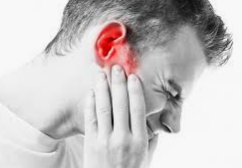Ear Pain MCQs :-
1. Otalgia. or ear pain, is generally caused by an inflammatory process.
- False
- True
2. A throat culture is the appropriate test for:
- TMJ disorder
- Cervical lymphadenitis
- Acute otitis media
3. Serous otitis is often painless and may be described as a bubbling, popping or stuffy sen sation in the ear.
- False
- True
4. Acute otitis media (AOM) refers to any inflammation of the middle ear and encompasses a variety of clinical conditions.
- True
- False
5. Cholesteatoma is caused by a mechanical process or Eustachian tube blockage that leads to inadequate ventilation of the middle ear and a collection of fluid that resembles mucus.
- False
- True
6. Otitis external or swimmers ear is related to pressure changes from scuba diving or flying.
False
True
7. The patient complains of pain in the skin and muscles of the neck and the ear canal. This is likely:
Barotraumas
TMJ disorder
Trauma
Cervical nerves (referred pain)
8. In infants younger than 2 months, fever with acute otitis media is common.
False
True
9. A tympanogram is an appropriate diagnostic test to confirm:
Acute otitis media
External otitis
Serous otitis
Mastoiditis
10. Chronic ear pain that is unresponsive to treatment may indicate cerumen impaction.
True
False

11. Assessment shows a pearly white lesion on or behind the TM. The patient has had some hearing loss and a recently perforated TM. This is:
Cholesteatoma
Cerumen impaction
Serous otitis
Mastoiditis
12. The patient has unilateral pain and a sensation of crackling or decreased hearing. Physical findings include a fluid line or air observed behind the TM, conductive hearing loss and decreased TM mobility. These are the symptoms of:
Mastoiditis
External otitis
Acute otitis media
Serous otitis
13. The most serious, although least common, cause of referred ear pain is nasopharyngeal cancer.
True
False
14. Assessment shows malocclusion and normal external and middle ear structures. The patient complains of unilateral pain that is worse in the morning. This is probably:
Barotraumas
TMJ disorder
Trauma
Cervical lymphadenitis
15. Chronic otitis media can result in anatomical changes to the tympanic membrane (TM) and middle ear ossicles, and this may predispose the child to additional ear infections.
True
False
16. Assessment shows enlarged, tender, cervical lymph nodes. There is a history of cervical node swelling and pain in the ear is common with children. This is:
Barotraumas
TMJ disorder
Cervical lymphadenitis
Trauma
17. Physical findings show perforation of the TM. The patient has a history of blunt or penetrating trauma. The cause of his ear pain is likely:
Trauma
Barotraumas
Cervical lymphadenitis
TMJ disorder
18. Children more often have an earache from external ear conditions or from referred pain from other head and neck structures.
False
True
19. Second-hand cigarette smoke exposure has been associated with a two to three-fold increased risk of otitis media.
False
True
20. TMJ pain is often described as severe pain lasting a few minutes and recurring three or four times per day, sometimes associated with a headache.
False
True
21. Assessment shows a build up of ear wax, a foul odor, and conductive hearing loss. The patient complains of pain or vague sensation of discomfort and decreased hearing. This is probably:
Mastoiditis
Serous otitis
Cerumen impaction
Cholesteatoma
22. Assessment shows red, bulging TM, fever, decreased light reflex and opaque TM. The young patient complains of unilateral, deep pain and a sensation of fullness. This is probably:
Acute otitis media
External otitis
Serous
Mastoiditis
23. ACM (acute otitis media) is more common among adults.
False
True
24. The patient has had a history of recent otitis media and chronic otitis pain behind the ear. Assessment shows swelling over mastoid process. fever, palpable tenderness, and erythema over mastoid process. This is likely:
Serous otitis
Cholesteatoma
Cerumen impaction
Mastoiditis
25. Assessment shows retraction of bulging of the TM. perforation of the TM and fluid in the canal. The patient has a history of flying or diving along with severe pain, hearing loss and sensation of fullness. These are the symptoms of:
Barotraumas
TMJ disorder
Trauma
Cervical lymphadenitis
26. Itching or drainage from the ear usually indicates an infection or inflammation of the external canal.
False
True
27. Malocclusion, bruxism and jaw click are common symptoms of:
Mastoiditis
Foreign body in ear
Trauma
TMJ disorder
28. The physical findings show discharge, inflamed, swollen external canal, pain with movement of the pinna with normal TM. The patient complains of bilateral itching and pain. This is likely:
Serous otitis
Mastoiditis
Acute otitis media
External otitis
29. A radiograph of the mastoid sinuses that reveals cloudiness indicates:
Barotraumas
Mastoiditis
Serous
Cervical lymphadenitis
30. Fever is absent in most children with acute otitis media.
False
True